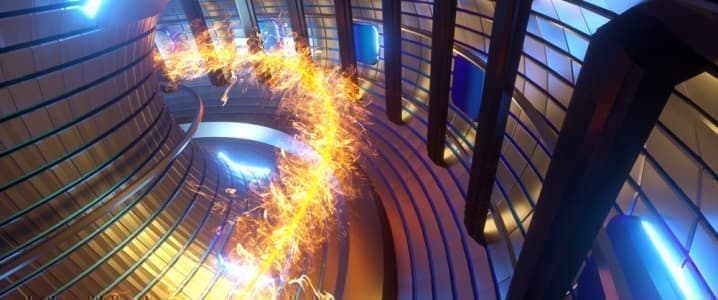Scientists have been searching for a way to produce a nuclear fusion reaction for decades, to develop commercial operations that can provide abundant clean energy. Several breakthroughs in the U.S. and U.K. in the past couple of years have shown great promise for the future of nuclear fusion, but many scientists believe we still have a long way to go before the technology can be deployed on a commercial scale. Meanwhile, China’s heavy investment in fusion research and development could put it ahead of the competition in the coming years.
Governments and private companies have been pumping huge levels of investment into scientific research aimed at achieving nuclear fusion for several decades. This is because fusion could generate around four times more energy per kilogramme of fuel than nuclear fission, which is the opposite process that is currently used in plants.
The International Energy Agency defines nuclear fusion as the process by which two light atomic nuclei combine to form a single heavier one while releasing massive amounts of energy. Fusion reactions take place in a state of matter called plasma—a hot, charged gas made of positive ions and free-moving electrons with unique properties distinct from solids, liquids, or gases…nuclei need to collide with each other at extremely high temperatures – around ten million degrees Celsius. When the nuclei come within a very close range of each other, the attractive nuclear force between them will outweigh the electrical repulsion and allow them to fuse.
In December 2022, a group of American scientists at the National Ignition Facility (NIF) at the Lawrence Livermore National Laboratory (LLNL) in California announced a breakthrough in nuclear fusion technology. During a fusion experiment, they were able to produce a higher energy output than was put in. The NIF experiment involved putting a minuscule amount of hydrogen into a capsule the size of a peppercorn and blasting it with a 192-beam laser to heat and compress the fuel. The laser heats the capsule to around 100 million degrees Celsius and compresses it to over 100 billion times the equivalent of the Earth’s atmosphere. This makes the capsule implode on itself so hydrogen atoms can fuse and release energy. The energy input totalled 2.05 megajoules and the group saw an output of 3.15 megajoules of fusion energy. After this initial success, the NIF scientists experienced further success when replicating the experiment.
In 2024, scientists at the U.K.-based JET laboratory achieved more energy production through a fusion process than anywhere ever before, following four decades of fusion research. While this showed great promise, the scientists who conducted the experiment were quick to point out the barriers to deploying nuclear fusion technology on a commercial scale. “In order for the atoms to fuse together on Earth, we need temperatures ten times hotter than the Sun – around 100 million Celsius, and we need a high enough density of the atoms and for a long enough time,” explained Dr Aneeqa Khan, Research Fellow in Nuclear Fusion, University of Manchester.
While the U.S. and U.K. have made significant strides in nuclear fusion, it is an Asian power that is expected to move ahead of the competition in the coming years. In China, the government is pumping huge quantities of funding into nuclear fusion research – between an estimated $1 and $1.5 billion a year. In comparison, the U.S. government is providing around $800 million a year in financing.
While private companies in both the U.S. and China believe it will be possible to roll out fusion power by the mid-2030s, China is moving at a record pace. The Shanghai-based startup Energy Singularity built its own tokamak – a complex cylindrical or donut-shaped machine that heats hydrogen to extreme temperatures – in its first three years, which is faster than any other company has built a comparable reactor. This is just one of several companies supporting China’s nuclear ambitions.
Energy Singularity has attracted $112 million in private investment and has used this funding to become the first in the world to use advanced magnets in a plasma experiment in its tokamak. These are high-temperature superconductors, which are stronger than the copper magnets used in conventional tokamaks. This could help smaller tokamaks produce as much fusion energy as much larger reactors. The firm hopes to develop a second-generation tokamak to show that its methods are commercially viable by 2027, and aims to build a third-generation reactor that can provide power to the grid before 2035.
By contrast, many of the U.S. tokamaks are outdated, which has led the country to rely on newer machines in Japan, Europe and the U.K. to advance its research. Andrew Holland, the CEO of the Washington, DC-based Fusion Industry Association, explained, “The Princeton Plasma Physics Laboratory has been upgrading its tokamak for 10 years now. The other operating tokamak in the United States, the DIII-D, is a 30-year-old machine. There’s no modern fusion facilities at American national labs.”
Nevertheless, the U.S. is continuing to advance its fusion research with the use of lasers. This month, construction began on a new $150 million facility at Colorado State University, which aims to develop laser-driven nuclear fusion. The Advanced Technology Lasers for Applications and Science (ATLAS) Facility will use three laser systems to simultaneously release almost 7 petawatts of power – over 5,000 times the total U.S. electrical generation capacity – in pulses lasting just 100 quadrillionths of a second. Operations are expected to commence at the plant in 2026.
The race continues to develop nuclear fusion technology capable of producing abundant clean energy, which could spell the end of the global reliance on fossil fuels. Despite significant strides by the U.S. and its allies in recent decades, the huge level of funding being seen in China could put the Asian giant ahead when it comes to nuclear fusion deployment in the coming decades.
By Felicity Bradstock for Oilprice.com
